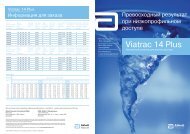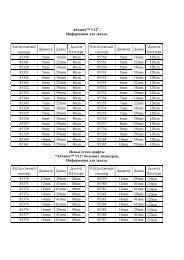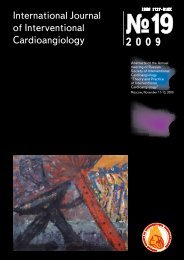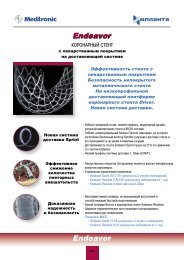Results of Coronary Stenting using the Stents with
Results of Coronary Stenting using the Stents with
Results of Coronary Stenting using the Stents with
Create successful ePaper yourself
Turn your PDF publications into a flip-book with our unique Google optimized e-Paper software.
Interventional cardiology<br />
and <strong>the</strong> absence <strong>of</strong> clear indications<br />
for surgery. Broad clinical introduction<br />
<strong>of</strong> endovascular methods <strong>of</strong> closure<br />
<strong>of</strong> pathological intracardiac communications,<br />
not requiring sternotomy<br />
and extracorporeal circulation and associated<br />
<strong>with</strong> an extremely low traumatism<br />
and high effectiveness again<br />
placed this problem in <strong>the</strong> agenda<br />
(2,5,9,10,11,12). While determining<br />
<strong>the</strong> tactics <strong>of</strong> treatment one should<br />
remember that despite left-to-right<br />
blood shunting <strong>with</strong>in <strong>the</strong> heart — leading<br />
to: (a) diastolic overload <strong>of</strong> <strong>the</strong> RV<br />
and <strong>the</strong> RA; (b) increase <strong>of</strong> pulmonary<br />
blood flow sometimes by several times<br />
over <strong>the</strong> systemic flow; (c) decrease <strong>of</strong><br />
blood input into <strong>the</strong> left heart and <strong>the</strong><br />
aorta, — significant changes <strong>of</strong> intracardiac<br />
hemodynamics, including<br />
marked pulmonary hypertension, can<br />
become evident not immediately, but after a certain,<br />
sometimes a long time, for example, after 20<br />
years and more. Hence, <strong>the</strong> absence <strong>of</strong> significant<br />
changes <strong>of</strong> intracardiac hemodynamics at <strong>the</strong> moment<br />
<strong>of</strong> examination should not be considered as<br />
a reason to refrain from ASD closure, as one has to<br />
consider this problem at a long term. In particular,<br />
this is true for <strong>the</strong> patients who already have some<br />
signs <strong>of</strong> CAD or a history <strong>of</strong> MI. This disease can enhance<br />
<strong>the</strong> appearance <strong>of</strong> significant disturbances<br />
<strong>of</strong> intracardiac hemodynamics due to <strong>the</strong> progressive<br />
LV failure. In adults this can be also influenced<br />
by <strong>the</strong> detraining <strong>of</strong> functionally underloaded left<br />
ventricle, <strong>the</strong> presence <strong>of</strong> arterial hypertension and<br />
o<strong>the</strong>r acquired heart diseases. Associated LV failure<br />
in patients <strong>with</strong> ASD can result in <strong>the</strong> increase<br />
<strong>of</strong> blood congestion in <strong>the</strong> right ventricular inflow<br />
tract. The more pronounced is left ventricular damage,<br />
<strong>the</strong> more significant will be <strong>the</strong>se changes. In<br />
particular, <strong>the</strong>y can be enhanced in <strong>the</strong> presence <strong>of</strong><br />
postinfarction LV cardiosclerosis.<br />
One also has to remember that <strong>the</strong> communication<br />
between <strong>the</strong> left and <strong>the</strong> right heart enhances<br />
<strong>the</strong> probability <strong>of</strong> thromboembolic complications in<br />
different organs, including <strong>the</strong> brain and <strong>the</strong> coronary<br />
arteries. Hence, <strong>the</strong> closure <strong>of</strong> <strong>the</strong> defect contributes<br />
to <strong>the</strong> decrease <strong>of</strong> <strong>the</strong> probability <strong>of</strong> thromboembolic<br />
complications.<br />
Finally, <strong>the</strong>re are evidences <strong>of</strong> <strong>the</strong> role played by<br />
ASD in <strong>the</strong> pathogenesis <strong>of</strong> migraine (13). The authors<br />
from Utah have shown that 25% <strong>of</strong> patients <strong>with</strong><br />
ordinary migraine and 50% <strong>with</strong> migraine <strong>with</strong> aura<br />
had ASD. Certainly, this problem necessitates fur<strong>the</strong>r<br />
investigation, however <strong>the</strong> presence <strong>of</strong> migraine in<br />
patients <strong>with</strong> ASD should be considered as an additional<br />
factor for positive solution <strong>of</strong> <strong>the</strong> problem <strong>of</strong><br />
endovascular ASD closure.<br />
Thus, while solving <strong>the</strong> problem <strong>of</strong> <strong>the</strong> choice <strong>of</strong><br />
tactics <strong>of</strong> treatment in adults <strong>with</strong> ASD one has to<br />
Fig. 7. Control TE-EchoCG in 1 month after <strong>the</strong> procedure<br />
Fig. 8. Axial heart section at <strong>the</strong> level <strong>of</strong> <strong>the</strong> ASD. The<br />
arrow indicates <strong>the</strong> occluder<br />
take into account <strong>the</strong> probability <strong>of</strong> association <strong>of</strong><br />
o<strong>the</strong>r cardiovascular conditions to this disease. With<br />
<strong>the</strong> course <strong>of</strong> time <strong>the</strong>se conditions can significantly<br />
worsen <strong>the</strong> prognosis in such patients. For this reason<br />
we consider reasonable to eliminate pathological<br />
communication between <strong>the</strong> heart chambers being a<br />
probable cause <strong>of</strong> heart failure.<br />
As to <strong>the</strong> simultaneous performance <strong>of</strong> two endovascular<br />
procedures in this contingent <strong>of</strong> patients, an<br />
extremely low number <strong>of</strong> cases makes it difficult to<br />
maintain pro or contra positions. Today we can only<br />
confirm <strong>the</strong> feasibility <strong>of</strong> such concomitant procedures<br />
<strong>with</strong>out any serious complications (14,15,16).<br />
Surely it is a positive moment for patients who can<br />
avoid repeated emotional stress related to <strong>the</strong> procedure<br />
and repeated hospitalization. Also <strong>the</strong> overall<br />
in-hospital stay is reduced (17). However in order to<br />
14<br />
(№ 26, 2011)
















